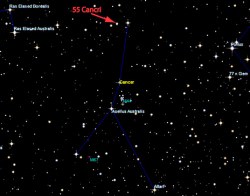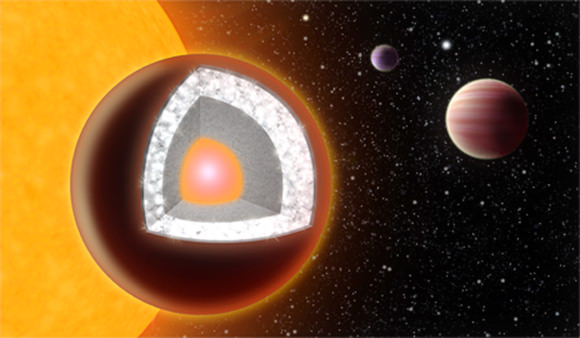Illustration of 55 Cancri e, a super-Earth that’s thought to have a thick layer of diamond (Yale News/Haven Giguere)
If diamonds are forever then this planet should be around for a very, very long time; it appears to be literally made of the stuff.
 55 Cancri e — an exoplanet discovered in 2004 — is more than twice Earth’s diameter and over eight times more massive, making it a so-called “super Earth.” Earlier this year it made headlines by being the first Earth-sized exoplanet whose light was directly observed via the infrared capabilities of NASA’s Spitzer Space Telescope.
55 Cancri e — an exoplanet discovered in 2004 — is more than twice Earth’s diameter and over eight times more massive, making it a so-called “super Earth.” Earlier this year it made headlines by being the first Earth-sized exoplanet whose light was directly observed via the infrared capabilities of NASA’s Spitzer Space Telescope.
Using information about 55 Cancri e’s size, mass and orbital velocity, as well as the composition of its parent star 55 Cancri (located 40 light years away in the constellation Cancer) a research team led by scientists from Yale University created computer models to determine what the planet is most likely made of.
They determined that 55 Cancri e is composed primarily of carbon (as graphite and diamond), iron, silicon carbide, and possibly some silicates. The researchers estimate that at least a third of the planet’s mass — the equivalent of about three Earth masses — could be diamond.
“This is our first glimpse of a rocky world with a fundamentally different chemistry from Earth. The surface of this planet is likely covered in graphite and diamond rather than water and granite.”
– Nikku Madhusudhan, Yale postdoctoral researcher and lead author
So what would one expect to find on a world made of diamond?
“On this planet there would basically be a thin layer below the surface which will have both graphite and diamond,” Madhusudhan told Universe Today in an email. “But, below that there will be a thick layer (a third of the radius) with mostly diamond. For a large part the diamond will be like the diamond on Earth, except really, really pure.
“But at greater depths the diamond could also be in liquid form,” Madhusudhan added.
Scientists had previously thought that 55 Cancri e might have a lot of water — superheated water, due to the planet’s incredibly high 4,000-degree (F) temperatures — based on the assumption that its composition is similar to Earth’s. But this new research indicates that it doesn’t have much water at all.
“By contrast, Earth’s interior is rich in oxygen, but extremely poor in carbon — less than a part in thousand by mass,” said Kanani Lee, Yale geophysicist and co-author of the paper.
This study shows that we can’t assume that planets in other systems are made of the same stuff that ours is, even if they are of similar size (and also that diamonds aren’t necessarily a valuable commodity on all worlds!)
The team’s paper “A Possible Carbon-rich Interior in Super-Earth 55 Cancri e” was accepted for publication in the journal Astrophysical Journal Letters. Read more on Yale News here.
Top image by Haven Giguere. Inset image shows visible location of 55 Cancri, by Nikku Madhusudhan using Sky Map Online.

